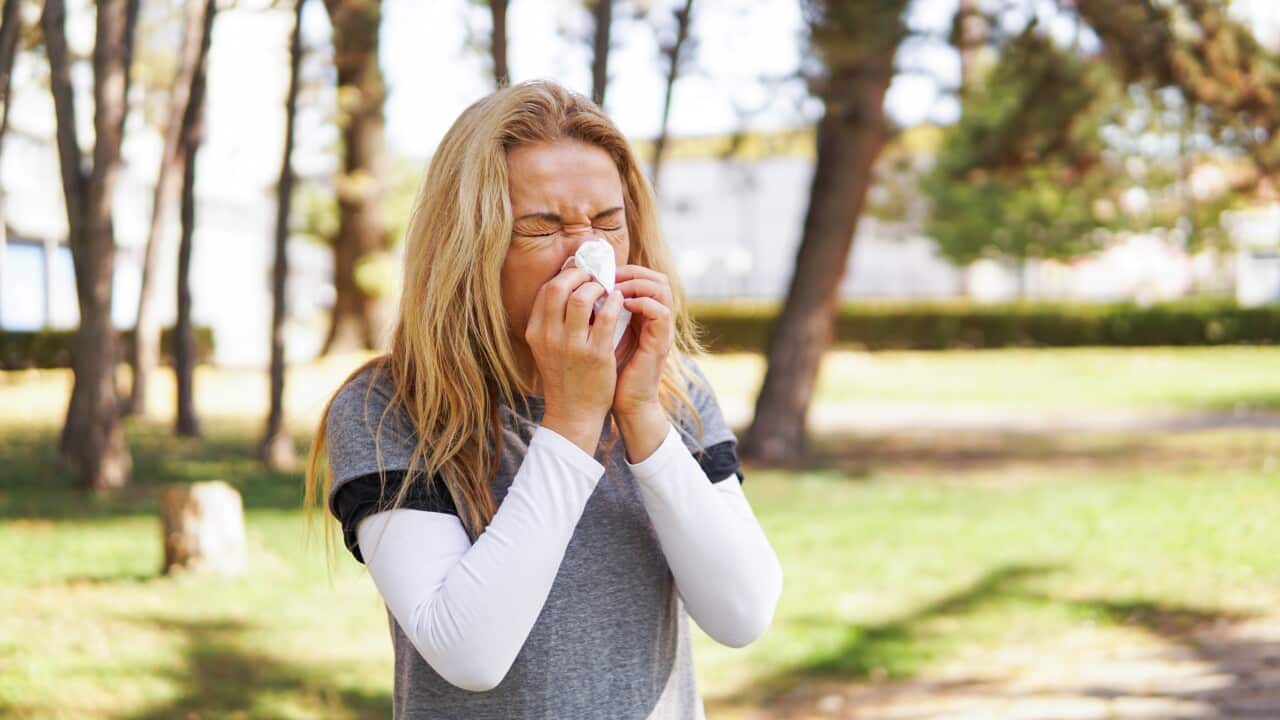Key Points
- حمى القش هي رد فعل مناعي مفرط تجاه حبوب اللقاح يسبب تهيجا في الأنف والعينين.
- يثار الربو عند دخول حبوب اللقاح إلى الرئتين، مما يسبب السعال والصفير وصعوبة التنفس
- ربع سكان أستراليا يعانون من حمى القش وحوالي ثلاثة ملايين مصابون بالربو
- الاستشارة الطبية أساسية عند ظهور الأعراض الأولى، والتوجيه الصحيح يساعد المرضى على إدارة حالتهم بفعالية
ما هي الحساسية الموسمية؟
مع قدوم الربيع تطلق الأعشاب والأشجار والنباتات حبوب اللقاح في الهواء، ما يثير لدى الأشخاص الحساسين ردود فعل مناعية تؤدي إلى حمى القش أو الربو التحسسي.
وتوضح البروفيسور المشاركة جوي لي، ، وهي طبيبة متخصصة في أمراض الجهاز التنفسي والرئيسة المشاركة لقسم الحساسية التنفسية في مركز التميز الوطني للحساسية أن "حبوب لقاح العشب هي السبب الرئيسي لالتهاب الأنف التحسسي المعروف أيضا بحمى القش، وكذلك للربو التحسسي الموسمي".
وتضيف " وكلاهما يُعرفان باسم الحساسية التنفسية" ماضية الى القول إن "نحو ربع سكان أستراليا يعانون من حمى القش، وحوالي 10 في المئة مصابون بالربو".
واردفت "غالبا ما يتعايش المرضان معا، فإذا أصبت بأحدهما فأنت أكثر عرضة للإصابة بالآخر".
وفي ولايات استراليا الجنوبية مثل فيكتوريا ونيو ساوث ويلز ومنطقة العاصمة الأسترالية، يُعد عشب "الرايغراس" المستقدم أبرز مسببات حمى القش، حيث يمتد موسم اللقاح من سبتمبر ايلول إلى يناير كانون الثاني، ويبلغ ذروته في نوفمبر تشرين الثاني .
أما في مناطق أخرى مثل كوينزلاند، فهناك أعشاب استوائية بمواسم تلقيح متأخرة قد تمتد حتى الصيف، لتشمل شهري فبراير شباط ومارس آذار، بحسب البروفيسور لي.
Dr Duncan Mackinnon, Micaela Diaz, Professor Joy Lee.
ما هي الأعراض الشائعة لحمى القش والربو؟
تشمل الأعراض النموذجية لحمى القش:
· العطاس وسيلان الأنف
· حكة ودموع في العينين
· انسداد الجيوب الأنفية وصداع
· الشعور بالإرهاق
وإذا وصلت جزيئات حبوب اللقاح إلى الرئتين، قد تظهر أعراض الربو مثل:
· السعال المستمر
· صفير في الصدر
· ضيق في التنفس
· إحساس بالانقباض في الصدر
وتصف ميكايلا دياز، المقيمة في بريزبن، أثر هذه الأعراض قائلة إن "الأعراض مزمنة بالفعل وأحيانا تجبرني على البقاء في المنزل، وتتفاوت بين حكة شديدة في الجلد وطفح جلدي، إلى العطاس والسعال وأعراض الجيوب الأنفية مثل انسداد الأنف، إضافة إلى حكة ودموع في العينين" ومضت الى القول إنها "تجعل مظهرك أحيانا أقرب إلى الزومبي".
A mother and son are sitting together in a living room. She is helping him take his puffer because he suffers from asthma. Credit: FatCamera/Getty Images
كيف يمكن إدارة الحساسية الموسمية؟
بالنسبة للكثيرين، قد تبدو الحساسية الربيعية مرهقة، لكن الاستعداد المسبق يساعد على التخفيف من الأعراض.
تشارك ميكايلا تجربتها قائلة إنه "مع اقتراب الربيع، أحرص على أن تكون لدي الأدوية المناسبة، وأغير مواعيد أو أماكن فتح النوافذ بحسب اتجاه الرياح".
واضافت "كما أغسل الملابس داخل المنزل أو آخذ الأغطية إلى المغسلة بدلا من نشرها في الخارج ، الأمر كله يتعلق بتقليل المخاطر بقدر المستطاع."
ما هي العلاجات الطبية المتاحة لحمى القش والربو؟
يقول الدكتور دنكان ماكينن، طبيب عام في نيو ساوث ويلز، إن الحساسية التنفسية تشكل ربع مراجعات عيادته في الربيع والصيف إن "معظم هذه الحالات تُعالج بأدوية متاحة من دون وصفة طبية، الأهم هو أن نُعلّم الناس كيف يديرون حالاتهم بأنفسهم."
ومن بين خيارات العلاج يبين ماكينن انها تشمل :
· مضادات الهيستامين (أقراص أو بخاخات) لتخفيف سريع من أعراض حمى القش
· مزيلات الاحتقان (يُنصح باستخدامها لفترة قصيرة فقط) لتخفيف انسداد الأنف
· أجهزة الاستنشاق فينتولينVentolin لتخفيف الربو
· بخاخات الكورتيكوستيرويد الوقائية (للأنف أو الاستنشاق) لتقليل الالتهاب، ويُفضَّل البدء بها قبل ذروة الموسم.
ما هو العلاج المناعي
وتشير البروفيسور جوي لي إلى وجود اختبارات متقدمة مثل اختبار الوخز الجلدي لتحديد مسببات الحساسية، إلى جانب علاجات متخصصة بحسب شدة الأعراض.
أما العلاج المناعي، فهو يقوم على إعطاء المريض جرعات صغيرة من المادة المسببة للحساسية بشكل متدرج حتى يعتاد عليها الجهاز المناعي.
وتوضح لي "نمنح المرضى جرعات صغيرة من مسبّب الحساسية، ليعتاد جهازهم المناعي عليها تدريجيًا بدلاً من رد الفعل المفرط عند التعرض لها".
Close-up of a car windshield covered in pollen and flower petals - the accumulation of allergens during the spring season. Source: iStockphoto / Manuel Milan/Getty Images
هل يمكن أن يؤثر الطقس على الحساسية؟
نعم، إذ تختلف مستويات حبوب اللقاح يوميا وتتأثر بعوامل الطقس. وتتوفر توقعات عبر الإنترنت وتطبيقات الهواتف، تُصنِّف الأيام إلى خفيفة، متوسطة، شديدة، أو شديدة للغاية.
كما يمكن أن تؤدي العواصف الرعدية إلى تفاقم الأعراض، مسببة ما يُعرف بـ"الربو الرعدي".
ويحذر الدكتور دنكان ماكينون قائلا "إن العواصف الرعدية هي مزيج من الرطوبة والحرارة مع الرياح الموسمية ويؤدي ذلك إلى إطلاق كميات هائلة من حبوب اللقاح في الهواء دفعة واحدة، وهو أمر خطير للأشخاص الذين يعانون من الحساسية".
وفي الأيام التي تشهد التلقيح العالي أو أثناء العواصف، يوصي د. ماكينن بخطوات تشمل :
· إبقاء النوافذ والأبواب مغلقة.
· تجنب البقاء في الهواء الطلق.
· ارتداء نظارات شمسية أو كمامة عند الخروج.
كيف يمكنك إعداد خطة إدارة الحساسية الموسمية؟
التحضير هو الأساس ، وتنصح البروفيسور جوي لي قائلة إنه "إذا كان لديك تاريخ من الأعراض في هذا الوقت من السنة، فمن المفيد استشارة طبيبك العام لوضع خطة مسبقة."
وتشمل الخطة:
· البدء مبكرا بالأدوية الوقائية.
· تجهيز العلاجات المهدئة في متناول اليد.
· متابعة توقعات مستويات حبوب اللقاح يوميا.
ورغم معاناتها، تحافظ ميكايلا على نظرة إيجابية مبينة ان "الأمر محبط… لكن لا بأس، لست وحدك .. يمكنك السيطرة على الأعراض وتجاوزها ؛ فقط يحتاج الأمر إلى وقت لتتعلم ما يناسبك."
موارد مفيدة لمرضى الحساسية
المعلومات الواردة في هذه الحلقة عامة وليست نصيحة طبية شخصية.
وإذا كنت قلقا من أعراض حمى القش أو الربو أو الحساسية، ينبغي عليك طلب الاستشارة الطبية من طبيبك أو الصيدلي للحصول على معلومات دقيقة تناسب حالتك.
وفي حالة الطوارئ، اتصل فورا بالرقم الثلاثي صفر (000).
اشترك في أو تابع بودكاست أستراليا موضَّح للحصول على مزيد من المعلومات والنصائح القيّمة حول الاستقرار في حياتك الجديدة في أستراليا.
اذا كانت لديك أسئلة أو مقترحات لموضوعات؟ راسلنا على البريد الإلكتروني: australiaexplained@sbs.com.au










